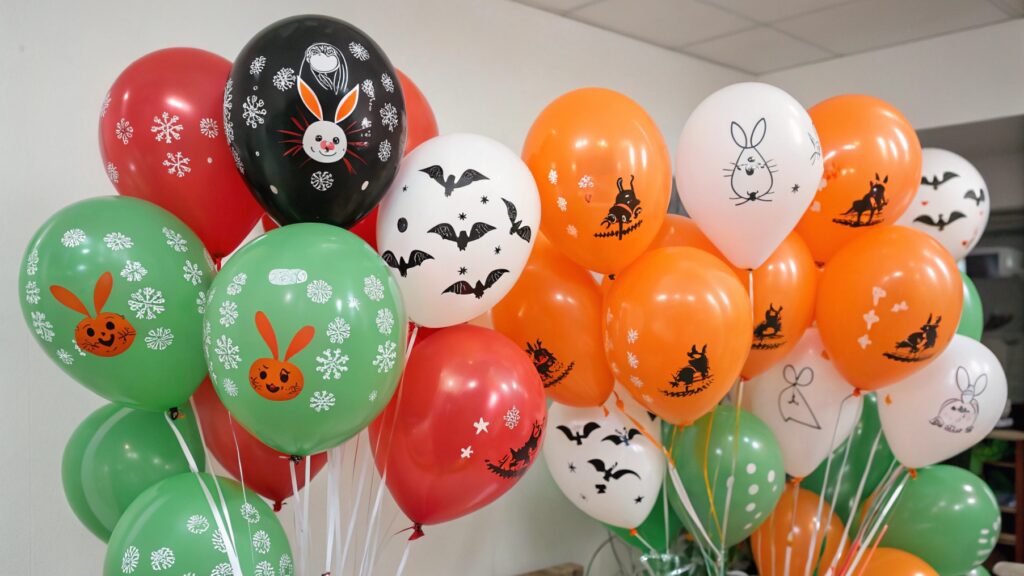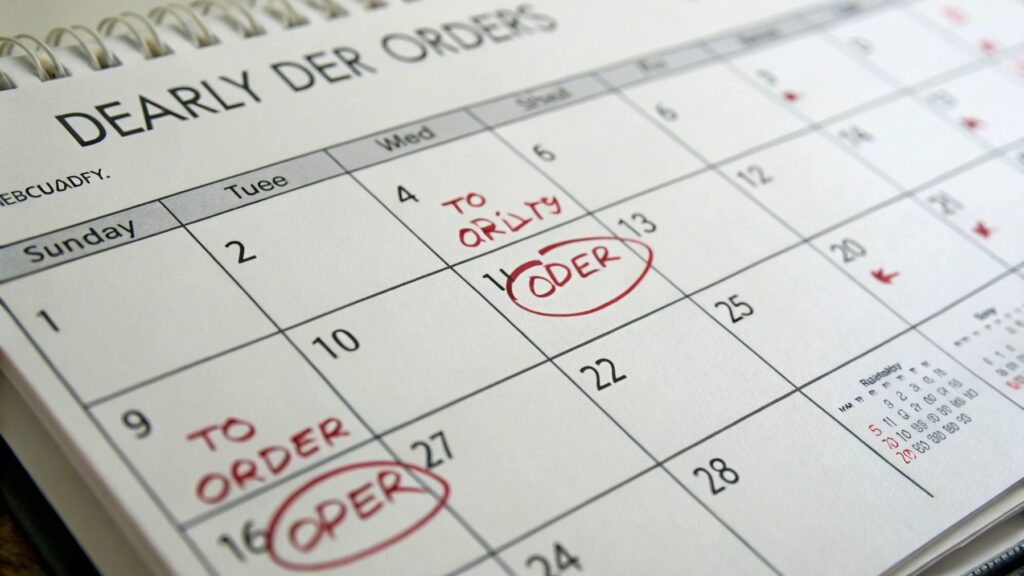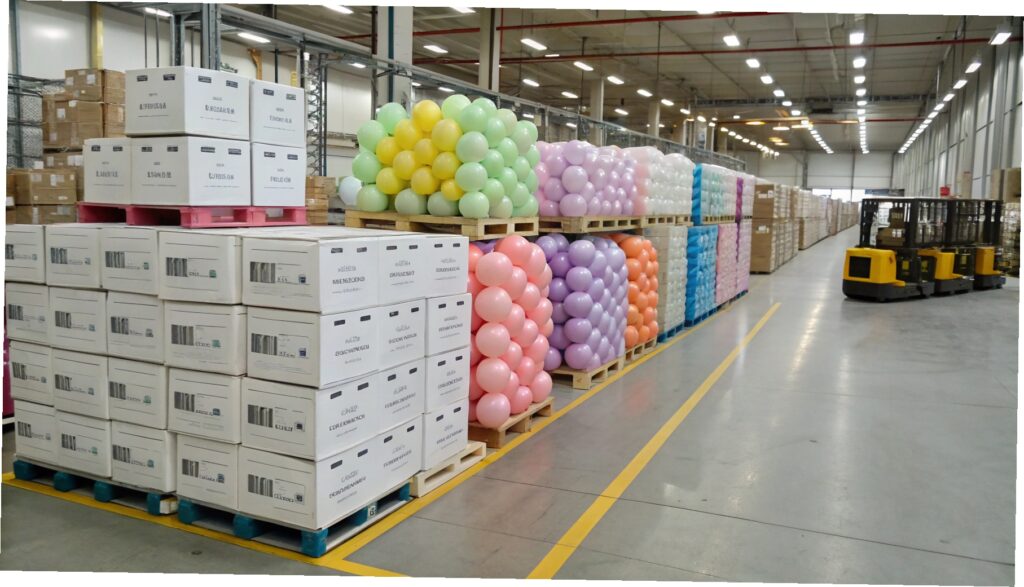How do seasonal demands impact latex balloon ordering?
Are you struggling to manage your balloon inventory? Do seasonal peaks catch you off guard, leaving you with shortages or excess stock? Let's talk about how the time of year affects what you need.
Seasonal demands significantly impact latex balloon ordering by creating peak periods for specific colors, shapes, and themes. Planning ahead, often months in advance, is crucial to ensure timely delivery and availability of popular items1 for holidays and events.

Managing seasonal demand for latex balloons can feel like a juggling act. It's not just about having balloons; it's about having the right balloons at the right time. Let's look at how to make this work for you.
What are the peak seasons for wholesale latex balloon orders?
Worried about running out of stock during busy times? Do you miss out on sales because you didn't order enough? Knowing the busiest times of the year is key.
Peak seasons for wholesale latex balloon orders typically include major holidays like Christmas, Halloween, and Easter, as well as events like graduations and summer parties. Demand for water balloons also peaks before summer.

From a factory point of view, balloon production2 doesn't stop. We make balloons all year. But what does change is what balloons customers order. For example, Christmas and Halloween balloons see a big jump in orders. This usually happens in April or May. Customers start planning early for the end-of-year holidays. Water balloons are another good example. People buy these in the winter. They get ready for the summer season ahead of time. So, while the factory is always busy, the mix of products we make changes with the seasons. This is why your planning is so important.
When do orders for holiday balloons3 usually start?
Orders for Christmas and Halloween balloons start early. Customers begin buying in April or May. This gives them enough time to get the products and distribute them before the holidays.
Why do people order water balloons4 in winter?
Ordering water balloons in winter prepares customers for summer. Summer is the peak time for water balloon use. Buying early ensures they have stock when demand is highest.
How do other holidays affect demand?
Other holidays like Easter, Valentine's Day, and Independence Day also create peaks. These holidays mean more parties and decorations. This increases the need for specific balloon colors and themes related to those dates. Graduation season in late spring is another busy time for balloon orders. These events require large quantities of balloons for decorations. Summer also brings demand for general party balloons. This is for birthdays, picnics, and outdoor events.
| Season | Peak Order Time | Popular Balloon Types |
|---|---|---|
| Christmas | April-May | Red, Green, White, Holiday shapes |
| Halloween | April-May | Orange, Black, Purple, Spooky shapes |
| Easter | December-January | Pastels, Bunny/Egg shapes |
| Summer | Winter-Spring | Bright colors, Water balloons |
| Graduation | Early Spring | School colors, Star shapes |
Understanding these patterns helps you plan your orders. It prevents shortages during the busiest times. It also helps avoid having too many of the wrong balloons after a season ends.
How early should I order latex balloons for holidays and events?
Feeling stressed about getting your holiday orders in on time? Are you worried about delays that could impact your sales? Let's figure out the best timing.
You should order latex balloons for major holidays and events at least 4-6 months in advance. For custom or large orders, placing your order even earlier, around 6-8 months ahead, is highly recommended to ensure production and shipping timelines are met.

Planning ahead is key, especially for big holidays like Christmas and Halloween. I see orders for these start as early as April or May. That's a full six to seven months before the holiday itself! This might seem like a long time, but there's a good reason. Production takes time. Shipping takes time, especially for international orders. Customs can add delays. When you order early, you give the factory enough time to make your balloons. You also give enough time for them to travel to you. This reduces the risk of not having your stock when you need it most. Think about water balloons too. People order these in winter. This is months before summer starts. It ensures they have inventory ready for the summer rush.
What happens if I order too late for a peak season?
Ordering too late can result in stockouts. You might not get the colors or shapes you need. This means lost sales. You might also face higher shipping costs to get the balloons faster.
How does custom printing affect ordering time?
Custom printed balloons need more time. Design approval, plate making, and printing all add to the lead time. Order custom balloons even earlier, maybe 6-8 months ahead of your event.
Is there a difference in ordering time for standard vs. specialty balloons5?
Yes. Standard round balloons are produced constantly. Specialty shapes or colors might only run at certain times. Ordering specialty balloons earlier is a good idea. This ensures they are in the production schedule. My experience shows that specific holiday-themed products often have dedicated production runs well in advance. If you miss that window, you might have to wait longer or miss out. Always check with your supplier about lead times for specific items, especially for seasonal or unique balloons. Planning your orders around the factory's production schedule, especially for seasonal runs, is the most effective way to ensure you get what you need on time.
Which latex balloon colors and shapes6 are most popular during specific seasons?
Unsure which balloon colors and shapes will sell best for upcoming events? Do you end up with unpopular stock after a season? Let's look at what's popular when.
During specific seasons, certain latex balloon colors and shapes gain popularity. Christmas sees demand for red, green, and white balloons and holiday shapes. Halloween favors orange, black, and purple with spooky shapes. Summer increases need for bright colors and water balloons.

Just like ordering time, the type of balloon changes with the seasons. For Christmas, everyone wants red, green, and white. Star shapes and maybe some custom holiday prints are popular. Halloween means lots of orange, black, and purple. Think about spooky shapes like ghosts or pumpkins. For Easter, pastel colors are big. Yellows, pinks, blues, and greens. Bunny and egg shapes are perfect. Summer is all about bright, vibrant colors. Reds, blues, yellows, everything sunny! And of course, water balloons are a must for summer fun. My customers start asking about these specific items months before the season hits. They know what sells.
Do trends change year to year for seasonal balloon popularity7?
While classic colors stay popular, trends can change slightly. New movie releases or popular themes can influence demand for specific colors or character prints. Staying updated on trends is helpful.
How important is color matching for seasonal events8?
Color matching is very important. Customers want balloons that match their party theme or corporate colors for events. Providing a range of shades helps meet these needs. For example, for a school graduation, the exact school colors are essential. Having those colors available is a major plus. Customers for corporate events also need specific brand colors.
Are there any shapes popular year-round besides rounds?
Heart shapes are popular for Valentine's Day but also used year-round for romantic events. Star shapes are good for graduations but also general celebrations. Animal shapes are popular for kids' parties any time of year. However, round and oval balloons are always the most consistent sellers across all seasons. Seasonal shapes provide a temporary boost in sales during specific times but won't replace the need for basic shapes. Focusing on a strong inventory of standard shapes and colors, with a strategic addition of seasonal items, is a balanced approach. This ensures you meet both everyday demand and seasonal peaks effectively.
Are there minimum order quantities for seasonal latex balloon purchases?
Concerned about meeting order minimums for specific seasonal items? Do you wonder if you have to buy more than you need? Let's talk about minimums.
Yes, there are typically minimum order quantities (MOQs) for seasonal latex balloon purchases, especially for items with specific colors, shapes, or custom printing. These MOQs help manage production efficiency for specialized items.

MOQs are a standard part of wholesale buying. For seasonal balloons, MOQs can be important. When we make a specific holiday shape or print, we set up machines for that item. There's a cost to setting up. To make it efficient, we need to produce a certain amount. This amount becomes the MOQ. For standard round balloons in basic colors, MOQs might be lower or more flexible. This is because we make them all the time. But for that ghost shape or Santa print, we might only run it for a limited time. The MOQ ensures that production run is worthwhile. From my side, MOQs help us plan production schedules effectively and keep costs down, which ultimately benefits you.
Why are MOQs often higher for custom or seasonal items?
MOQs are higher for custom or seasonal items because they require dedicated production runs. Setting up equipment for a specific color, shape, or print is more efficient when producing a larger quantity.
Can MOQs be negotiated?
Sometimes, MOQs can be discussed, especially if you are a long-term customer or placing a very large overall order. However, for highly specialized seasonal items with limited production windows, MOQs are often firmer due to production constraints. It's always best to communicate your needs with your supplier. They can explain their MOQ policies and potentially offer alternatives if a specific MOQ is a challenge. I always try to work with our customers to find a solution that works for both of us, especially when it comes to planning for seasonal demand.
How do MOQs impact inventory management for seasonal items?
MOQs mean you might need to purchase more seasonal items than you immediately plan to sell during the peak. This requires careful forecasting and planning to manage your inventory and avoid leftover stock after the season ends. Buying too little means you miss sales. Buying too much means you have dead stock. Understanding the MOQ and accurately predicting demand is key to balancing this. You need to factor the MOQ into your sales projections for that specific season.
Conclusion
Seasonal demands greatly affect balloon orders, driving peaks for specific products during holidays and events. Ordering months ahead is vital for availability.
-
Explore effective strategies to guarantee that your popular balloon items are always in stock when needed, especially during peak seasons. ↩
-
Explore this link to understand how balloon production adapts to seasonal demands and customer preferences, ensuring you stay ahead in the market. ↩
-
This resource will provide insights on the best timing for ordering holiday balloons, helping you avoid last-minute rushes and stock shortages. ↩
-
Discover the reasons behind winter purchases of water balloons and how it relates to summer planning, ensuring you're prepared for peak demand. ↩
-
Exploring the differences in lead times for specialty balloons can ensure you order them in time for your events. ↩
-
Discovering popular latex balloon colors and shapes for each season can help you stock effectively and meet customer demand. ↩
-
Understanding seasonal balloon trends can help you stock the right items and boost sales during peak times. ↩
-
Color matching enhances the overall aesthetic of events, ensuring customer satisfaction and repeat business. ↩
